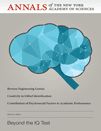From the abstract: "Hands-on science is the ideal platform for observing young children's ability to solve problems, think deeply, and use their creative ingenuity to explore the world around them. Science is naturally interesting and offers authentic reasons to read for information and use math skills to collect, compile, and analyze data. This chapter will share one approach to nurturing and recognizing young children with high-potential: U-STARS∼PLUS (Using Science, Talents, and Abilities to Recognize Students∼Promoting Learning for Underrepresented Students). Each of the five components (high-end learning environments; teacher's observations of potential; engaging science activities; partnerships with parents; and capacity building for system change) will be explained. Concrete examples will be given for each area showing how it works and why it is important. Special attention will be paid to the needs of educationally vulnerable gifted children who remain underserved: racially, ethnically, and linguistically different; economically disadvantaged, and children who are twice exceptional (2e)."
Citation
DOI

